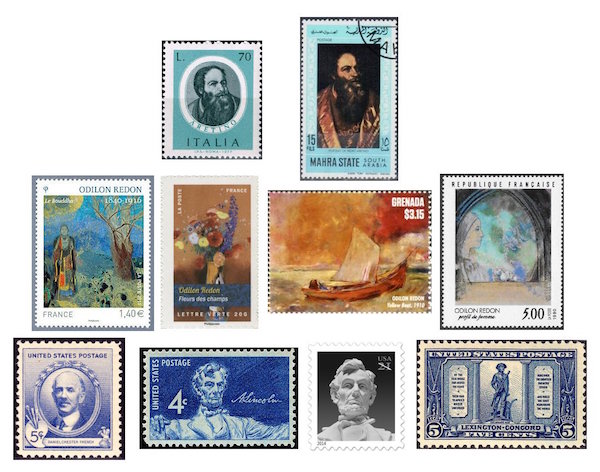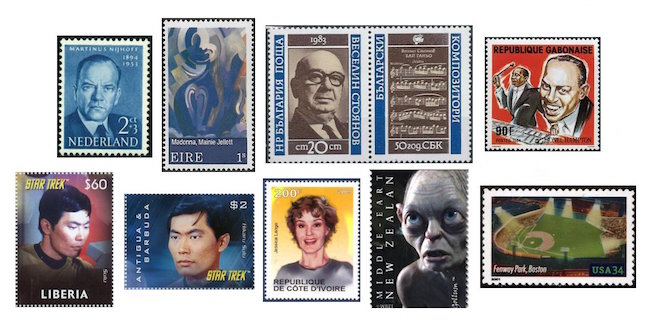The Arts on the Stamps of the World — April 20
An Arts Fuse regular feature: the arts on stamps of the world.

By Doug Briscoe
Today’s top artists include painters Joan Miró and Odilon Redon, American sculptor Daniel Chester French, jazz man Lionel Hampton, and comic genius Harold Lloyd. Miró and Lloyd were born on exactly the same day, April 20, 1893.
The Renaissance Italian satirist and rogue Pietro Aretino (20 April 1492 – 21 October 1556), to begin with, was said to have been banished in his teens from his native city of Arezzo, presumably, if true, because of some scurrilous pamphlet or other. But, looked after by his mother’s “gentleman friend”, the illegitimate Pietro went to Perugia for seven years, studying painting and writing his first poems. Then it was on to Rome, where he wrote a mock elegy on the death of the Pope’s elephant, a work that set him on his career. His next project? A set of sixteen Sonetti Lussuriosi (“luxurious” in the Shakespearean sense) for a book of pornographic drawings by Giulio Romano, whereupon Aretino had to hightail it out of Rome for a while. He continued to find powerful patrons, though, one of whom was a Medici cardinal whose rivals were satirized by Aretino’s relentless pen. One of those discomfited gentlemen even tried to have Aretino assassinated. And so on to Venice, where he took up the art of blackmail, himself apparently unthreatened by his freely acknowledged penchant for young men. His effectiveness as a satirist reached the point that both King Francis I of France and the Holy Roman Emperor Charles V kept him on the payroll to keep their enemies hopping. Aretino was a good friend of Titian, who painted two portraits of him, one of which, from 1545, we see on the stamps.
In the second row we see some of the work of the fine French symbolist painter Odilon Redon (April 20, 1840 – July 6, 1916). Odilon got his name, which was originally Bertrand-Jean, from his mother Odile. He studied drawing and architecture, but failed the architecture exam and pursued painting (with Jean-Léon Gérôme), sculpture, etching, and lithography. He came to the attention of the public in a roundabout way when his paintings were cited as a plot device in Huysmans’ famous 1884 novel À rebours (Against Nature). Redon became interested in the East, and one of his numerous representations of the Buddha is seen in the French stamp at left.

The third row is devoted to American sculptor Daniel Chester French (April 20, 1850 – October 7, 1931), whose best known work, I think quite rightly, is the noble and magnificent statue of Abraham Lincoln created in 1920 for the Lincoln Memorial in Washington, D.C. French’s works can be seen all over America, but more than a few can be found right here in Massachusetts, again with one of them being more famous than all the rest: The Minute Man in Concord (1875), also seen on a US stamp of 1925. Some of the others are the John Harvard Monument in Harvard Yard (1884), the statue of Wendell Phillips (1915) in the Boston Public Garden, the John Boyle O’Reilly Memorial (1896) on the Fenway, busts of Charles Russell Lowell (1885) and William Francis Bartlett (1881), both in Annenberg Hall at Harvard, an equestrian statue of William Franklin Draper (1912) in Milford, the Milmore monument (Death and the Sculptor, 1889) in Forest Hills Cemetery in Jamaica Plain, and, back in Concord, the Melvin Brothers monument (1908) in Sleepy Hollow Cemetery.
Daniel Varoujan (20 April 1884 – 26 August 1915) was a victim of the Armenian genocide. Born Daniel Tchboukkiarian in Sivas in central Turkey, he completed his education in Istanbul, Venice, and Ghent. He returned to his hometown in 1909 to become a teacher. In that same year he had published his second volume of poetry Zeghin Sirde (The Heart of the Race). In 1912 he went with his family back to Istanbul and put out his collection Het’anos Erger (Pagan Songs). Two years later he co-founded the literary movement Mehian (Temple) and its concomitant magazine. He was arrested on the infamous Red Sunday (April 24, 1915) and, months later, with four other intellectuals, was brutally and sadistically murdered with knives in a forest. His posthumous collection The Song of the Bread (1921) was apparently saved by the bribing of Turkish officials.
The work of Joan Miró (20 April 1893 – 25 December 1983), as you might expect, is amply represented on stamps of the world. From his native Spain we have La Bague d’ Aurore (1957) and Fusées (1959), from Guinea-Bissau a Self-Portrait of 1919, from the Czech Republic Composition (1933), and from Romania and France two abstracts for which I could find no other title and no dates.
Harold Lloyd (April 20, 1893 – March 8, 1971), Charlie Chaplin, and Buster Keaton make up the immortal triumvirate of comedy stars of the silent screen. Although all of them worked in talkies, too, they seemed to do their finest, most inspired work for the silents. Lloyd started wearing the big lensless glasses because it was thought he was too good-looking for comedy. In the next year, 1919, he was severely injured, not in one of his timeless physical stunt gags, but because a smoke-emitting prop exploded in his hand, causing the loss of a thumb and forefinger as well as burns to his face. Luckily, he did not lose sight in his injured eye. In later years, mindful of his good fortune, he would devote much energy to the Shriners Hospital for Crippled Children. Only the fourth to be chosen to leave his prints in the concrete of Grauman’s Chinese Theatre, he broke from “tradition” to leave an imprint of his glasses. Lloyd is one of many celebrities to be honored on US stamps with a caricature by Al Hirschfeld.

Dutch poet and essayist Martinus Nijhoff (April 20, 1894 – January 26, 1953) is held by some readers in very high regard indeed. Joseph Brodsky felt that Nijhoff’s long poem Awater (1934) was one of the greatest poetical works of the 20th century. Het Uur U (U-Hour, first published in a magazine in 1936, in book form in 1942) is also held up as another proof of Nijhoff’s greatness as a poet. He was born and died in The Hague. Since 1955 there has been an annual translation prize given in his name.
Irish painter Mainie Jellett (20 April 1897 – 16 February 1944) began with Impressionism but on encountering Cubism turned to abstract art and was one of the first to exhibit an abstract piece (Decoration) in her home town of Dublin in 1923. She and her companion Evie Hone were both fervent Christians, and the stamp shows one of Jellett’s Madonnas, the Madonna of Eire. Together with three other artists Jellett and Hone founded the Irish Exhibition of Living Art in 1943.
Bulgarian composer Veselin Stoyanov (20 April 1902 – 29 June 1969; pron. sta-YAH-nuff) studied in his native Sofia and with Franz Schmidt and Joseph Marx in Vienna. He wrote three operas, two symphonies, and five concertos, among other works. I’ve never heard a note of any of them. This stamp and label are from a set generously given to me by Marc-André Hamelin. The label shows the score for Stoyanov’s symphonic suite “Bai Ganyo”.
Jazz musician Lionel Hampton (April 20, 1908 – August 31, 2002) was born in Louisville, Kentucky, but grew up in Alabama, Wisconsin, and Chicago. He began his professional career playing drums but early on took to the vibraphone, which had only recently been invented. He worked with Louis Armstrong, Nat Shilkret, and Benny Goodman before forming his own orchestra. In 1953 Hampton wrote a King David Suite, which he performed in Israel with the Boston Pops. Since 1985 the University of Idaho has held an annual Lionel Hampton Jazz Festival, and the university was the first in the country to name its music school for a jazz musician.

We have three more movie actors in today’s birthday group: Star Trek alumnus and progressive activist and blogger George Takei (born 1937); Jessica Lange (born 1949), winner of two Oscars (Tootsie, 1982, and Blue Sky, 1994), along with five Golden Globes, three Emmys, a Tony, and a SAG award; and Gollum, my preciousss, Andy Serkis (born 1964). Mr. Takei’s stamps come from the profusion of Star Trek issues out there, Ms. Lange’s from a rather expansive Ivoirian set of popular American actors, and Mr. Serkis is seen only as his CGI alter ego on a New Zealand Lord of the Rings stamp (which we used earlier this year to celebrate J.R.R. Tolkien). Happy birthday, all!
Now I don’t do sports, as a rule, but so many people so dearly love baseball that I thought I’d mollify the lynch mob by marking the 105th anniversary of the first game played at Fenway Park. No doubt you already knew that the Red Sox won over the New York Highlanders (soon to be the Yankees) 7-6 in extra innings. That was on April 20, 1912.
A graduate of the University of Massachusetts with a B.A. in English, Doug Briscoe worked in Boston classical music radio, at WCRB, WGBH, and WBUR, for about 25 years, beginning in 1977. He has the curious distinction of having succeeded Robert J. Lurtsema twice, first as host of WGBH’s weekday morning classical music program in 1993, then as host of the weekend program when Robert J.’s health failed in 2000. Doug also wrote liner notes for several of the late Gunther Schuller’s GM Recordings releases as well as program notes for the Boston Classical Orchestra. For the past few years he’s been posting a Facebook “blog” of classical music on stamps of the world, which has now been expanded to encompass all the arts for The Arts Fuse.
